
29 minute read
Highlighting various Art Exhibitioners on PAN Amsterdam
Diplomat Affairs magazine, in partnership with PAN Amsterdam Director Mark Grol and in collaboration with Tableau publisher Ms. Dominique van der Mee, are delighted to present a collection of articles highlighting various Art exhibitioners.
GUIDANCE AND TRANSLATION BY MS. JULIE KENNEDY
BILDHALLE AN ESTABLISHED NAME IN PHOTOGRAPHY
Bildhalle is a Swiss photography gallery with one branch in Zurich and two in Amsterdam. Bildhalle is going all-out for its first participation at PAN Amsterdam, with a wide selection of outstanding photography, including both classic and contemporary works.
The gallery has developed, since its creation in 2013 by Mirjam Cavegn, into one of the leading galleries of photography in Switzerland. In 2020, Bildhalle opened a branch at Hazenstraat 15H in Amsterdam and in September 2021 expanded this further with a second branch at Willemsparkweg 134H. The gallery showcases a well-chosen selection of Dutch and international photographers, a mix of both young talent and established photographers. Bildhalle will exhibit works by photographer Ilona Langbroek. Her emotional series Silent Loss reveals an intimate and mysterious world of opulence and beauty. This personal series is based on the history of her family from the Dutch East Indies. Langbroek’s work touches on the lost identity of the large number of people who were forced to leave their country after the Indonesian independence. She depicts this loss through a metaphorical representation of memories and fantasies in poetic images, strongly influenced by the painting techniques of the Dutch masters of the Golden Age. These pieces will be shown alongside the most recent works of Bastiaan Woudt, who celebrates his ten-year anniversary as a photographer in 2021. His career has seen a tremendous development in the past decade, which has left an unmistakable mark on the world of contemporary art photography. The charcoal tones and elegant compositions in Woudt’s work make the viewer feel as if they are in a modern painting, witnessing the elegant dance between light and shadow. Bildhalle also presents works by Dutch photographer Casper Faassen. Faassen’s work is characterised by unique, powerful lines, a beautiful play of light and a continuously innovative application of materials and techniques. He combines photography with layers of painting, creating a contrasting effect by placing the subject of ‘beauty’ alongside the form of ‘decay’, with an enchanting result. We also go back in time to the year 1952, when Swiss photographer René Groebli went on his honeymoon to Paris with his wife Rita. The trip resulted in the series The Eye of Love and constitutes a visual love poem. Vintage prints made by the photographer himself in 1952 will be on display. Finally, the iconic work Ali Left Fist will be displayed. The work was shot in 1966 by Thomas Hoepker - a Master of Photography. He won his first award for this medium aged 14 and in 2003, at the age of 57, he was appointed president of Magnum Photos. Bildhalle cordially invites you to visit its booth and get acquainted.
In September 2021, Bildhalle opened its second branch in Amsterdam with the solo show RHYTHM by Bastiaan Woudt.
Bildhalle Hazenstraat 15H NL-1016 SM Amsterdam +31 20 241 47 48
Willemsparkweg 134H 1071 HR Amsterdam +31 20 808 88 05 info@bildhalle.nl
< Bastiaan Woudt, Elegance, 2021, 120x90cm or 185x135cm, archival pigment print on Innova Baryta Paper, ©Bastiaan Woudt, Elegance, 2021, courtesy of Bildhalle
> Casper Faassen, Igoné Marron, 180x150cm, Oil paint, color and white print on setasand, ©Casper Faassen, Igoné Marron, 2020, courtesy of Bildhalle
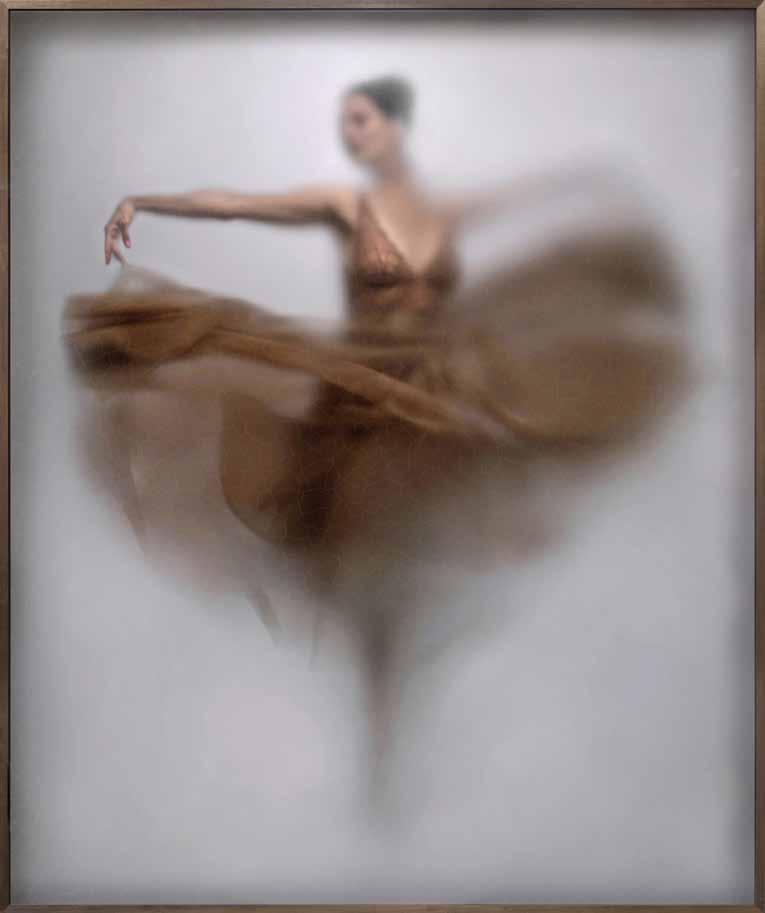
DOUWES FINE ART (SINCE 1770)
Each generation has added its own unique expertise and vision to the company since it was founded in 1770. Now, in its 8th and 9th generation, Douwes Fine Art offers five centuries of paintings, works on paper and sculpture.
Instead of specialising in just one era or style, we have chosen to use our extensive expertise in five centuries of painting to our advantage. This enables us to offer a wide variety of Dutch, Flemish, French, Russian and international works of art and to put Art into perspective over the centuries. Not only do we have significant, rare, and valuable paintings, but we also try to enthuse each and every young collector by offering quality art at favourable prices. Our unique collection of art of quality is the result of over 250 years of expertise in buying and selling art, as well as of our knowledge of conservation and the restoration of durable works of art. We are delighted to be able to physically welcome our clients once more at the PAN fair, after the past 1.5 year of ‘seclusion’. Many new, positive developments have emerged from this period of enforced isolation. Our new website and social media channels have actually broadened the contact with our customers during this difficult time and increased our reach. One surprising effect we noticed during this period, was an increased interest, in many of our Dutch clients, for their own environment. They saw anew the importance that art can bring to our lives now that there was more awareness within the personal environment.

The traditional, conscientious art dealer is a passionate collector at heart
Technological innovation provided more opportunities for connection. Douwes Fine Art, however, believes that art is best experienced in its original form. Physically experiencing a work of art can provoke authentic and powerful emotions and true art is born from these emotions. This is the sort of art that we, at Douwes, call Art with a capital ‘A’. Our deepest wish is that our fine family tradition will be able to pursue this in an enjoyable way, and that we may be able to continue serving collectors and potential buyers with the best knowledge we have at our disposal. We look forward to welcoming you to our stand for this special edition of PAN 2021 and otherwise our gallery will be open to the public from Tuesday to Friday and by appointment.
Douwes Fine Art Johannes Vermeerstraat 15-hs 1071 DK Amsterdam www.douwesfineart.com info@douwesfineart.com tel: +31 (0) 20664 6362
< Evert and Evert-Anthony Douwes
> Cornelis Springer (Amsterdam 1817 – 1891 Hilversum), The ‘Huis met de Hoofden’ in Amsterdam aan de Keizersgracht 123, 1853, oil paint on panel: 66x55cm, signed, monogrammed and dated ‘53, Literature: W. Laanstra Cornelis Springer, p. 84, no. 53-6. Amsterdam, 1984.
> Piet Ouborg (Dordrecht 1893 – 1956 Den Haag), Op Geel Ovaal, c. 1947- 1948, gouache on paper, 35,5x50cm, expertise: authenticated by W. Jos de Gruyter

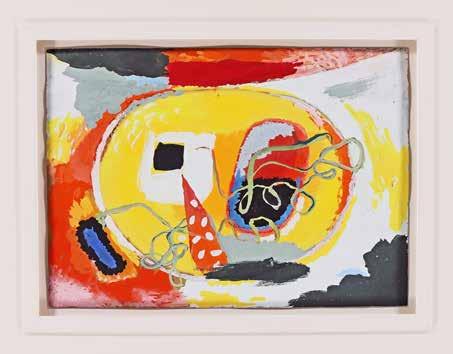
ART DEALERSHIP E.J. VAN WISSELINGH & CO FOCUS ON THE MAÎTRES FRANÇAIS
Art dealership E.J. van Wisselingh & Co, was founded in 1838 in London and Amsterdam. Owner Willem de Winter established the company in Haarlem. The gallery specialises in Dutch and French masters from the 19th and 20th centuries.
Matthijs Maris, Marius Bauer, George Hendrik Breitner, Willem Witsen and Willem de Zwart are among some of the Dutch artists who sold many of their works of art at Van Wisselingh. But famous works by Gustave Courbet, Daumier and Jongkind also changed hands here. The company also had a furniture workshop around the turn of the century, where three artists, Gerrit Willem Dijsselhof, C.A. Lion Cachet and Theo Nieuwenhuis, worked. They designed interiors, mainly for Amsterdam notables and the workshop executed the work. Many of these items are now among the finest and most elaborate objects made in the Netherlands in the Art nouveau or Jugendstil period. A wonderful example of this is the so-called Nieuwenhuis-room in the Rijksmuseum, which comes from an Amsterdam home. Taste, in the 19th and early 20th centuries, was not determined by museums but mainly by the art trade and private collectors. Several of these collectors, who regularly bought paintings, watercolours, drawings, prints and furniture from Van Wisselingh, donated their collections to Dutch museums in the first half of the 20th century. The Rijksmuseum acquired the collections of Van Lynden, Westerwoudt, Hoogendijk, Van Randwijk, Reich, and Van Wezel, who were all regular clients of Van Wisselingh.
The gallery E.J. van Wisselingh & Co will mainly be focussing on the ‘Maîtres Francais’ during PAN, with works by Eugène Boudin, Charles Francois Daubigny, Francois Bonvin, Antoine Vollon, Maximilien Luce, Eugène Galien-Laloue, André Brasilier, Alexandre René Veron, Eugène Louis Lami, Théodore Rousseau, Théodule Augustin Ribot & André Marchand. A particular work of interest is the painting of Deauville, Le Bassin by Eugène Boudin (1824 - 1898) dating from 1896. Manuel Schmit confirmed that this painting will be included in the yet to be published Supplement III of the Catalogue Raisonné of the paintings by Eugène Boudin (1824 - 1898).

Taste in the 19th and early 20th centuries, was mainly determined by art dealers and collectors
Gallery E.J. van Wisselingh & Co Willem de Winter Baan 41, 2012 DC Haarlem www.wisselingh.com Mob. +31 (0)6 – 547 06 555 Mail. info@wisselingh.com
< Eugène Galien- Laloue (1854-1941), Place du Châtelet, Paris, gouache, signed, 32 x 39 cm.
> Eugène Boudin (1824 – 1898), Deauville, Le Bassin, 1896, oil paint on panel, signed and dated ‘96, 32,5 x 41 cm.
> Ferdinand Joseph Gueldry (1858 – 1945), Clermont Ferrand, oil on cardboard, signed, l.o. 21,5 x 35 cm.
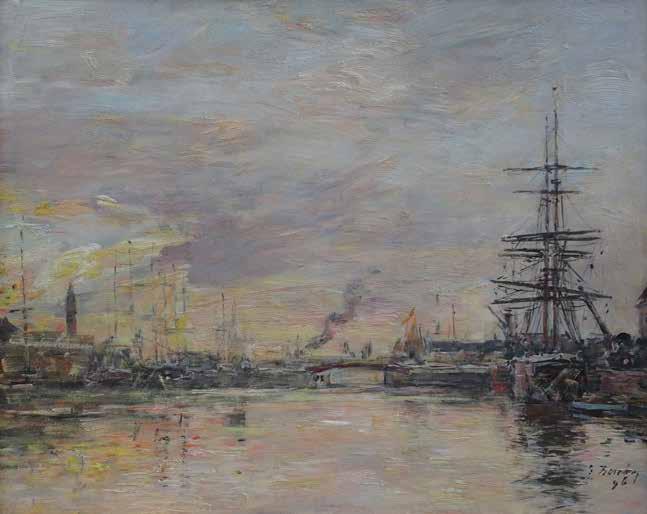
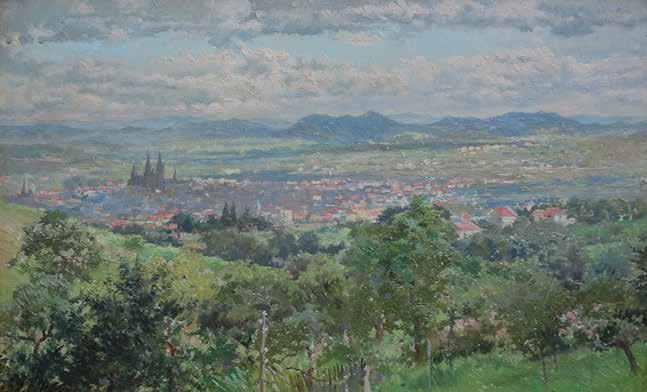
IVO BOUWMAN THE HAGUE - PARIS – AMSTERDAM
Central to the almost fifty years I have been dealing in works of art, is the interaction between Dutch and French artists. This is particularly so with Isaac Israels and J.B. Jongkind, two artists who constitute the red thread running through my existence as an art dealer to this day.
I have taken part, over the course of the past decades, in dozens of art fairs at home and abroad, from Delft, Amsterdam and Maastricht to London, Johannesburg, New York and Hong Kong. The outcome of these art fairs has been variable; at times extremely good, but at others barely breaking even or even making a small loss, but I always made new, interesting contacts. This has led me to always approach each fair with great enthusiasm and optimism. As a young art dealer, I rapidly made the acquaintance of Victorine Hefting, the Jongkind expert by definition, and of Isaac Israels specialist Anna Wagner. These two ladies from The Hague inspired me to fullheartedly promote and showcase works by both masters. J.B. Jongkind and Isaac Israels have formed the core of the works I displayed at all exhibitions. I also kind of felt like a pioneer by showing these Dutch artists abroad, as I was introducing people to artists who were previously totally unknown to them. Seen that most of Jongkind’s works were found in France, I also gradually became interested in his French contemporaries, particularly in the representatives of impressionism. The developments in France around the turn of the century have always been an inexhaustible source and inspiration for me. It went from impressionism to pointillism, fauvism, and cubism. First in France, but then these movements also impacted artists in the Netherlands. Think of Kees van Dongen, Jan Sluijters and Leo Gestel. It was a fascinating time! Such an unimaginable number of beautiful works of art were created within a half century. This period has come to lie at the heart of my trade in art. Isaac Israels, as a Dutch painter, is inextricably linked to this. Having studios in Paris, London, and The Hague, many of his paintings are linked to these cities in terms of subject. He liked to capture the models and sewing ateliers of the various fashion houses. The painting on the right, Essayeuses chez Paquin from 1905, was once part of the collection of Dr J.H. Reisel in Amsterdam. A larger version of the same painting can be found in the Dordrecht Museum. My great friend Jongkind was not only a fantastic painter, but above all a great watercolourist. Anyone having seen a large retrospective of Jongkind, will conclude that Jongkind was one of the great precursors of impressionism. A perfect example is the watercolour from 1866 shown here. Where a Dutch contemporary would have depicted the same subject in great detail, Jongkind only gives an impression of the whole and thus proves himself a true master. Ivo Bouwman

Art gallery Ivo Bouwman Jan van Nassaustraat 80 2596 BW Den Haag www.ivobouwman.nl info@ivobouwman.nl 00-31 (0)6-53928822
< J.B. Jongkind (18191891), Bateaux sur l’Escaut pres d’Anvers, 1866, aquarelle, gouache and graph-ite on papier, 19,5x34cm, signed and dated bottom right
> Isaac Israels (18651934), Essayeuses chez Paquin, 1905, canvas, 87x50cm, signed bottom right

Ubbens Art has something to celebrate, namely the fifth birthday of the gallery. And to celebrate this first lustrum it is participating, for a second time, in PAN.
Ubbens Art, in its 60 square metre stand (112), showcases a selection of stunning, mysterious, and surprising paintings and works on paper. The period from 1800 to 1950 is superbly represented with movements such as the (late) Symbolism, Romanticism, and the Dutch Impressionism of the Hague School and the Tachtigers (The Eighties movement). You will also find works by the so-called traveller-painters. Artists who did not hesitate to seek out adventure in order to transfer it to paper or canvas. The house’s speciality is indeed ‘where smaller masters have their moments of brilliance’; idiosyncratic scenes within the oeuvre of the ‘petits maîtres’, at home and abroad.

Ubbens Art Brediusweg 62, 1401 AJ Bussum +31657202292 jop@ubbensart.com www.ubbensart.com
< Karel de Neree tot Babberich (1880-1909), Walden, titled verso, East-Indian ink on paper, 35x22cm, dated around 1901.
> Serafino Macchiati (1861-1916), Self-portrait, signed with initials, oil paint on canvas, 14x21cm, dated around 1900-05.
> Ferdinand Hart Nibbrig (1866-1915), Zoutelande, signed, oil paint on canvas, 40x60cm, painted between 1910-15.
A good example of this, is the mysterious and somewhat melancholic self-portrait at table by the Italian Serafino Macchiati. Another out of the ordinary piece that fits perfectly with the gallery’s style, is a lyrical black-and-white drawing, almost abstract, by artist Dirk Govert van Luijn, from Utrecht, dating September 1921. Ubbens Art prides itself on exhibiting as many unique pieces of work as possible within the oeuvre of small, yet well-known artists.


MENTINK & ROEST ANTIQUE DEALERS AND HOROLOGISTS QUALITY IS TIMELESS
Mentink & Roest is renowned for its exceptional collection of clocks. You can hear time’s discreet voice all around you in the elegant clock room of the monumental manor house, where clocks of sublime beauty steadily tick away the minutes and then exuberantly strike the hour and half hour.
PAN AMSTERDAM L. XVI OEIL DE BOEUF
Striking ornate brass tendrils and garlands wind around the case of this Louis XVI oeil de boeuf made of patinated bronze. The white enamelled dial plate, combined with the finely pierced, engraved hour and minute hands, form an elegant whole. This French clock, dating from circa 1790, has an hourly and half-hourly striking mechanism, and a running time of one week.
THE HAGUE CLOCK
This ‘Hague clock’ stands in its full glory and makes the collector’s heart flutter. High-quality silver ornaments adorn the ebony-veneered clock with black lacquered Roman numbering and beautifully finely pierced hour and minute hands. This Dutch clock, which dates from around 1680, has an hourly striking mechanism and a running time of one week. It bears the elegant signature of master clockmaker Joseph Norris Amsterdam. its small size of 8.5 cm diameter. This 17th century clock has an hourly striking mechanism with quarter repeat and was crafted around 1690 in Germany. The richly engraved clock carries the graceful signature of clockmaker Wilhälmus Köberle Eichstet.
Outstanding combinations of beauty, craftsmanship and knowledge
THE ATMOS TIMEPIECE, TRANSPARENT AND ETERNAL
The Parisian engineer and inventor J.L. Reutter designed this type of clock, which uses differences in temperature to keep the movement in motion. This French Atmos clock’s balance wheel steadily turns in the nickel-plated brass case with faceted glass walls. It dates from the 1930s and is signed Atmos Pendule Perpetuelle.
WILHÄLMUS KÖBERLE EICHSTET’S TABLE CLOCK
This hexagonal gilt-brass Table clock is monumental despite Mentink & Roest Antique Dealers is known worldwide for its collection of antique clocks, barometers, and scientific instruments of museum quality. Authenticity and quality, craftsmanship and expertise, discretion and integrity are in our DNA. Our company, located in the Betuwe village of Ingen, specialises in quality and exceptional clocks from the 16th to the 19th century. Thanks to our own restoration workshop, all objects are in impeccable condition. Our philosophy is to warmly welcome the collector, in a fresh and accessible environment where quality, reliability, rarity and exclusivity are visible and guaranteed. We look forward to meeting you at our stand, at PAN Amsterdam 2021.
Mentink & Roest BV Molenstraat 22 4031 JS Ingen The Netherlands 0344-603606 www.mentinkenroest.com


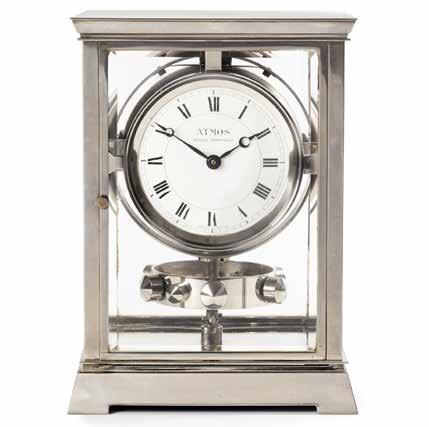
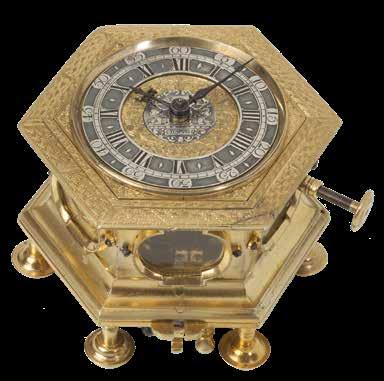
PAUL RUITENBEEK A LOVE OF SYMBOLISM AND CRAFTSMANSHIP
Paul Ruitenbeek specialises in early Chinese ceramics and works of art dating up to the 18th century. The gallery is located on the Herengracht in Amsterdam and can be visited on appointment. Paul Ruitenbeek Chinese Art is member of the Royal Association of Fine Art Dealers in the Netherlands since 2021.
High quality objects of art have been manufactured in China since as far back as the early Neolithic period, over three thousand years before Christ. Each period has its own charm, often influenced by religion, customs, the exchange between different cultures and the availability of knowledge and materials. Fascinating among these, is the world of the Chinese literati, who, for centuries were inspired by nature and history. The objects they admired and used, reflect this par excellence. These scholar’s objects are often elegant and discreet and made out of a broad variety of materials. This particular category will be widely represented during PAN in, among other things, bronze, jade, lacquer, wood, porcelain, glass, and bamboo. Ceramics are also central to the collection, pieces that were almost exclusively intended for the Chinese market, from burial ceramics to imperial porcelain. A private collection of ceramics from the Song dynasty (960-1279) will be showcased amongst others, including a very refined Qingbai porcelain lidded jar (pictured left).
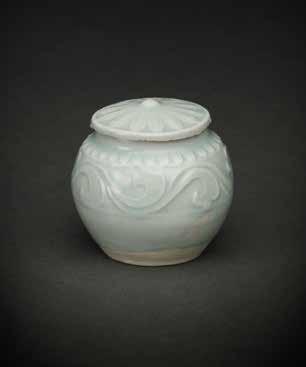
JADE
The carved jade boulder (pictured right), dating from the 18th century, is an impressive object full of hidden symbolism. It depicts in deep relief, with great precision and artistic skill, a mountain landscape with, on the right-hand side, a scholar and servant on their way to a pavilion situated higher up. They cross a waterfall on the way, via a natural bridge. Pine trees and lingzhi, the fungus of longevity, grow from the rocks, and are also held in both figures’ hands. Remarkably, the other side is also beautifully decorated with pine trees, deer and lingzhi. Depth is created on both sides, by several layers of relief, enhanced by the orange-brown areas that have been used exclusively for the outer layer. One important aspect, besides the outstanding quality of the material and craftsmanship, is the underlying symbolism. This is created by no fewer than five hidden elements, namely the rocks, pine trees, deer, lingzhi and the waterfall, which all symbolise longevity.
Paul Ruitenbeek Herengracht 390 1016 CJ Amsterdam www.paulruitenbeek.com E: paulruitenbeek.art@ gmail.com T: +31(0)645716465
< Qingbai porcelain lidded jar, China, Song dynasty, 12th-13th century, 7.1cm high.
> Jade boulder on wooden stand, China, Qing dynasty, 18th century, 17.6cm wide, 9.8cm high.

RUEB MODERN AND CONTEMPORARY ART RUEB, BACK ON THE PAN AFTER 8 YEARS
Rueb Modern and Contemporary Art is presenting several works by internationally renowned artists at this edition of PAN. They will be showcasing for instance, an important video by Bill Viola and a cubist drawing by Pablo Picasso dating from 1915.
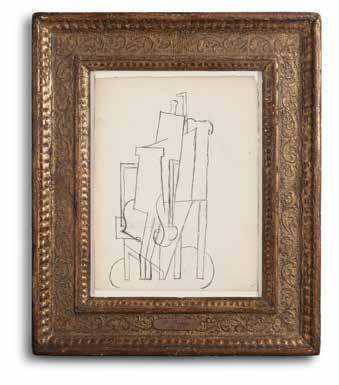
In Bill Viola’s 2005 video diptych, entitled Ablutions, we see a man and a woman performing the ritual of washing their hands side by side. This physically repetitive act is the preparation for a transcendent experience, namely a symbolic rebirth. The two plasma screens are part of Viola’s sevenpart Purification series in which ritual acts are central. Viola developed as teenager a passion for the poems by the Spanish mystic Saint John of the Cross, a spiritual source of inspiration that still resonates in his work today. The video shown here is a wonderful example of this. The drawing by Picasso is extraordinary as his cubist work is rarely on the market. It shows a figure sitting on a chair and can be dated to 1915. Picasso made several variations on this subject in that year, of which Harlequin on a Chair from MOMA is a well-known example. Picasso is seen as the father of Cubism, a style that questions the traditional way of perceiving and depicting and radically breaks with the classical linear perspective. The provenance of this work is also interesting: it comes from the collection of Picasso’s granddaughter Marina, who received a fifth of the estate. She uses the proceeds from the works to support projects for children in need. Another interesting work is a cubist drawing by Tamara de Lempicka ca 1923. After fleeing the Russian Revolution, she arrived in Paris in 1919, where she immersed herself in the bohemian world of the international art scene. De Lempicka is best known for her much-demanded art deco portraits of powerful women and modern men. In addition to work by established names such as Viola, Picasso and De Lempicka, Rueb is exhibiting works by contemporary artists who are currently in the spotlight. One example is a painting by Norbert Schwontkowski, a German artist who had a solo exhibition in the Kunstmuseum Den Haag earlier this year. His work is inspired by Zen Buddhism and storytelling, that ancient quintessential human activity. His work therefore has a strong meditative and narrative character, with often a humorous touch. All these aspects come together in the work on display here.
Rueb Banstraat 4 1071 JZ Amsterdam T: 020 676 75 66 M: 06 22 80 59 62 info@rueb.nl www.rueb.nl Bezoek volgens afspraak
< Pablo Picasso (1881- 1973), ‘Personnage assis dans un fauteuil’, (1915), Pencil on paper, 32.5x23.5 cm
> Bill Viola (1951), ‘Ablutions’, (2005), colour video diptych on 2 plasma screens, 101.5x122x10.8 cm, ed 2/7 (+1 AP)
> Norbert Schwontkowski (1949-2013), ‘Unter Wasser gehen’, (2002), Signed verso-oil on canvas 40x50 cm

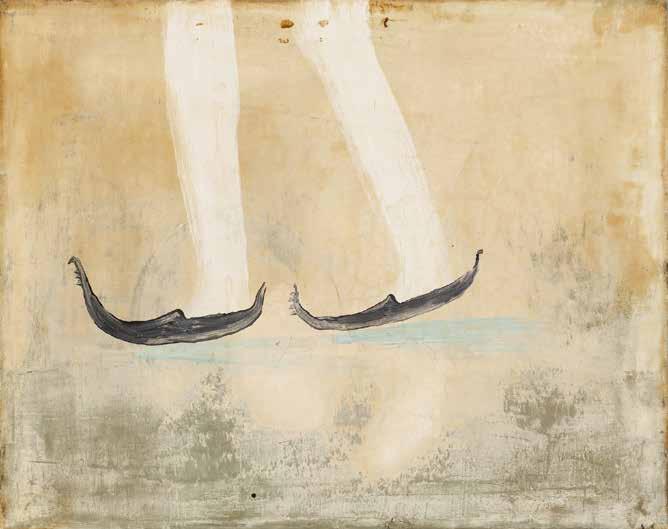
a S AT e The former National Sea Arsenal shimmers in the morning sun. The impressive, white-plastered building, designed in 1656 by Daniel Stalpaert and which served as a warehouse for the Admiralty of Amsterdam, now houses the treasures of Het Scheepvaartmuseum, the Netherlands Maritime Museum. It has now been five years since Michael Huijser took office as the museum’s new director. Time to reflect on the past years and cast a glance at the future, starting with the special exhibition of ‘Willem van de Velde & Son’.
By Floor Wiegerinck

When Michael Huijser took over as director of the Maritime Museum in the summer of 2016, the museum was in dire straits. Huijser: “When I became director, it was unclear what exactly the museum stood for. This led us to draft a new vision and mission: Water connects worlds. What is the relationship between the visitors and the maritime history of the Netherlands? How does it affect individuals and their family history? Worlds come together when you share all these stories.”
FRESH WIND
The museum is also mounting two new permanent exhibitions, ‘Republic by the Sea’ and ‘Cartography and Curiosities’, in an attempt to tell a broader story by illuminating history from different angles. This often sounds easier than it is. Huijser: “What we struggle with as Maritime Museum is that as a society, we want to capture everything in clichés. But reality is so much more subtle. We always aim, as a museum, to try to paint as complete a picture as possible. One of the ways we do so, is by inviting the public to tell their story and by listening to the questions the public asks about history.
Another challenging factor is that the sources of information handed down are mainly from a European perspective. One example of this is the painting Braziliaans landschap (Brazilian Landscape) by the painter Frans Post, dating from 1650. The museum complements the artist’s painting by emphasising what is not shown here. Namely, the 25,000 enslaved people forced to work on the sugar plantations of the WIC. Or it emphasises elements which were ignored for a long time. Like the African man in the portrait of Cornelis Tromp, painted by Ferdinand Bol around 1676. Sources tell us nothing about this man, but at least now, he has a right to exist. Huijser: “When the museum acquires a work of art, we always look at the story told by the painting. We are looking in particular for the context behind a work of art so that we not only interpret the period in which it was created, but also the times in which we live today.

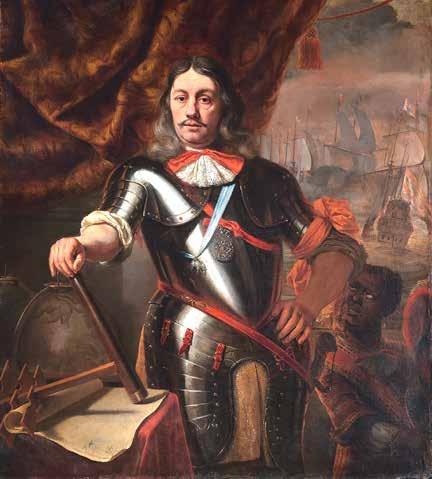
PAST, PRESENT, FUTURE
Huijser’s ambition as director is to connect maritime history with the present and the future in a surprising and innovative way. Huijser: ‘I think that the past, present, and the future are all connected, and I find it interesting to interpret history in a very practical way. It often turns out for example that what is happening nowadays is not all that different from what happened in the past. We currently think that we have a refugee problem, but we have always been a country that took in refugees. We were already doing so in the 16th century. The National Maritime Museum also involves contemporary art in its exhibitions. Such as Hans Op de Beeck and his
<< Willem van de Velde the Younger, Gezicht van Engelse oorlogsschepen op een rede na, 1672, oil on canvas, 105x89cm, The Kremer Collection
< Frans Post, Braziliaans landschap, 1650, oil on panel, 22,5×28cm, coll. Rijksmuseum
< Ferdinand Bol (attributed), Luitenant-admiraal Cornelis Tromp (1629- 1691), around 1667, oil on canvas, 148,5×31cm, coll. Het Scheepvaartmuseum
> Willem van de Velde the Younger, Het verzamelen van de Nederlandse vloot voor de Vierdaagse Zeeslag, 11- 14 juni 1666, 1670, oil on canvas, 133,5x202,5cm, Moveo Art Collection 2019 ‘Sea of Tranquillity’ exhibition where he created a total experience, depicting his vision of the future of cruise liners and the world around them. Or the exhibition ‘Angels of the Sea’ for which Stephan Vanfleteren photographed all 108 boys from Royal Work IBIS, a family replacement training institute in Bredene, Belgium. The National Maritime Museum is also looking to the future. ‘We held, at the beginning of this year for example, the exhibition ‘Rising Water’ with work by Kadir van Lohuizen, in which he made the global impact of the rising sea level visible. This is not only relevant to us, but also to the rest of the world. That is why we have made it into a travelling exhibition. The museum places sustainability at the forefront, hence we also try to make the exhibition as sustainable as possible. By uploading for example, the photos locally, so there is no need for transportation. In this way, we make an exhibition on sustainability, a sustainable project in itself.’ This autumn will see a long-cherished wish come true: an exhibition on the marine artists Willem van de Velde the Elder and Willem van de Velde the Younger. Huijser: ‘Even before I became director, there were plans for an exhibition on Willem van de Velde and his son. Unfortunately, something always came in-between, and it never got off the ground. When I became director, I decided that this exhibition had to go ahead no matter what’.
MARITIME PAINTING
Maritime painting is a Dutch invention and gets into its stride around 1600, with painter Hendrick Cornelisz Vroom (15661640), as one of the most important founders of this genre. The Reformation at the end of the 16th and early 17th century, saw a shift in theme within the world of painting, from the religious to more bourgeois topics. Portraits, landscapes, ››
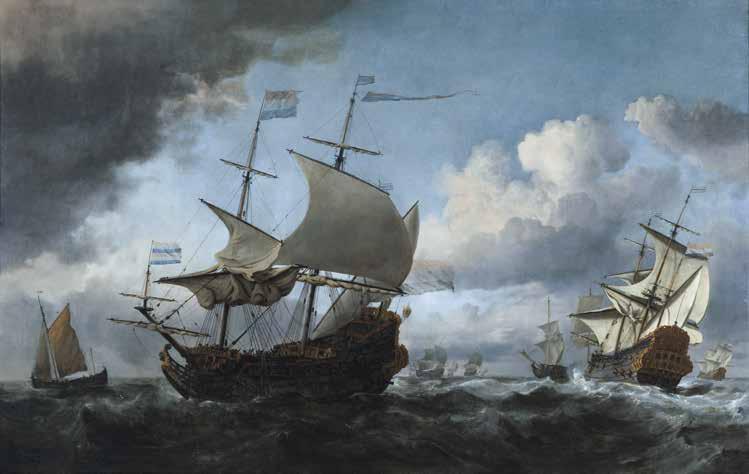
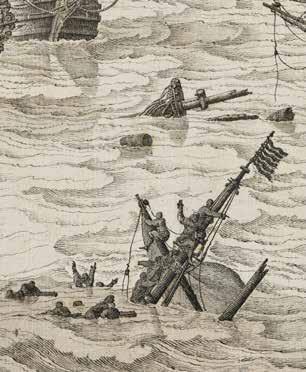
but also seascapes became increasingly popular. At the end of the 16th century, the Republic of the Netherlands increasingly developed into a major naval power. After the fall of Antwerp in 1585, the port of Amsterdam grew into the largest port in Europe. The Dutch East India Company was founded in 1602, and the Republic gained a trade monopoly on the Baltic Sea. The sea also witnessed many battles. There was the Eighty Years’ War, and the Republic also became involved in three Anglo-Dutch wars after the Treaty of Munster in 1648. The main issue was domination over the North Sea. These developments led to the growing popularity of maritime painting and the demand from all walks of life for these masterpieces increased enormously. Huijser: ‘A total of around three million paintings were made in the 17th century, which is a gigantic amount. A large part of these were of low quality and often large-scale production work that was sold for little money. The art of printing also enabled a wider distribution of etchings and engravings, making it possible for artists to become known throughout Europe. Willem van de Velde and his son leapt right into this market with their specialised and detailed maritime works of art.
< Willem van de Velde the Elder, De zeeslag bij Nieuwpoort, 1653-1654
< Willem van de Velde the Elder, De zeeslag bij Nieuwpoort, 1653-1654, ink on panel, 96x146,5cm, long-term loan from the Foundation Vaderlandsch Fonds ter Aanmoediging van ‘s Lands Zeedienst.
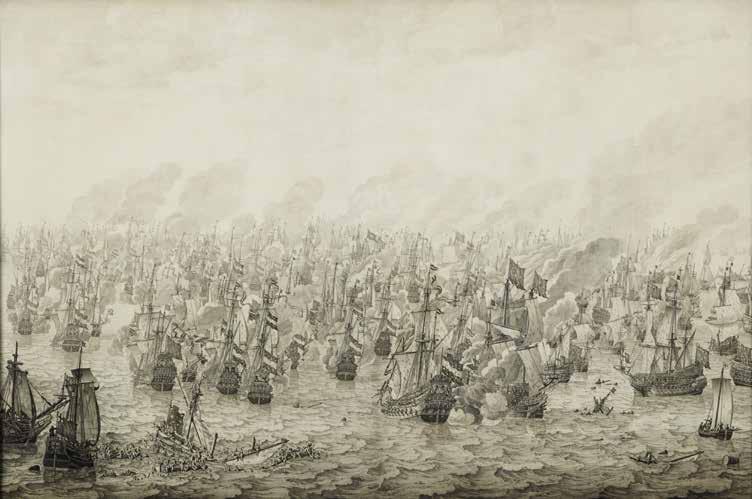

> Willem van de Velde the Younger, Een Engels schip in een stormachtige wind, circa 1700, oil on canvas, 32x38cm, coll. National Maritime Museum, Greenwich, London
WILLEM VAN DE VELDE & SON
Willem van de Velde the Elder was born in Leiden in 1611 into a sea-faring family. It is not known exactly when he began drawing or whether he received any training. Willem van de Velde the Elder married Judicgen Adriaensdr van Leeuwen and in 1633 a son was born: Willem van de Velde the Younger. The family moved at some point during the following years to Amsterdam, as their son Adriaen was baptised in the Oude Kerk in 1636. It was in Amsterdam that Willem van de Velde the Elder started work as a ship’s draftsman. His drawings were mainly published as prints and, at first, sold separately. His sons both followed in their father’s footsteps. Willem specialised in marine paintings and Adriaen developed as a landscape painter. Willem van der Velde the Elder and his son Willem built up a successful business specialising mainly in maritime paintings. It is not entirely clear whether Adriaen also played a role in the family business.
PAINTER AT SEA
One of the reasons for the Van de Velde success was that Van de Velde the Elder sailed between 1653 and 1673 as a ship’s draughtsman in the major naval battles fought during the Anglo-Dutch Wars. He was the first painter ever to sail with the fleet. He drew and sketched the progress of the battle from a galleon, a small sailing ship that sailed between the large ships carrying messages. He used large sheets of paper which he then stuck together to create a long strip, sometimes as much as nine metres long. Once back home, he worked out his drawings in minute detail with pen on canvas or panel. Huijser: ‘What fascinates me in the work of Van de Velde the Elder is the degree of detail, and thus also the amount of misery. If you look closely at the paintings, you can see figures jumping overboard or bodies flying through the air after a cannon shot. You have the freedom to leave these kinds of details out as an artist. This makes him not only an exceptional draughtsman but also a reliable source of history. Van de Velde the Younger also went to sea several times. Willem van de Velde the Younger already learned the tricks of the trade from his father from an early age. He was also apprenticed to marine painter Simon de Vlieger, a good friend of the family. Willem van de Velde the Younger specialised in oil paintings. Like his father, he had a keen eye for detail, but could also convey the atmosphere of a naval battle with a good sense of colour and composition.
THE OTHER SIDE OF THE CANAL
In 1672, the economic growth of the Republic started to stagnate as not only England but also France declared war on the Republic. Whereas earlier, the Van de Veldes had profited from the great demand for paintings of naval battles and portraits of ships and captains, now the art market collapsed completely. This was then the moment for the artists to accept the invitation of the English king Charles II to become his court painters. Huijser: “There is no question here of desertion or defecting to the enemy. Many people left the Republic that year as a better income could be earned abroad. The Van de Veldes furthermore had extensive knowledge of sea battles and how they were formed, which suited the English King very well.
PERSPECTIVE
Huijser: ‘Determining how to approach the exhibition on Willem van de Velde and his son was a real challenge. At first, we wanted an art-historical perspective, but we felt, as a museum, that it is important to offer visitors a context of the period in which this work was made. That is why we finally opted for a cultural-historical approach.’ For a moment it seemed that Corona would throw a spanner in the works, but thankfully the exhibition could be postponed for a year. Huijser: ‘Fortunately, all the loans were also available a year later. There are loans from The Royal Collections, Greenwich and also from the Royal Collection in the Netherlands. Our own King is lending a work by Van de Velde the Younger that normally hangs in his study. Of course, the newly acquired Solebay tapestries will also be on display. It promises to be a very special exhibition. ››
Willem van de Velde and son, The National Maritime Museum (Het Scheepvaartmuseum) 1 October 2021to 27 March 2022










